The breeds of modern dogs are very diverse and the potential owner can choose any pet, based on their taste and wallet. Fans of miniature companions will surely like an adhesive tape terrier. What are these four-legged creatures?
Material Content:
Description and characteristics of the breed
Before you get a pet from the coast of Scotland, it will be useful to study the description of the breed and the features of caring for these animals.
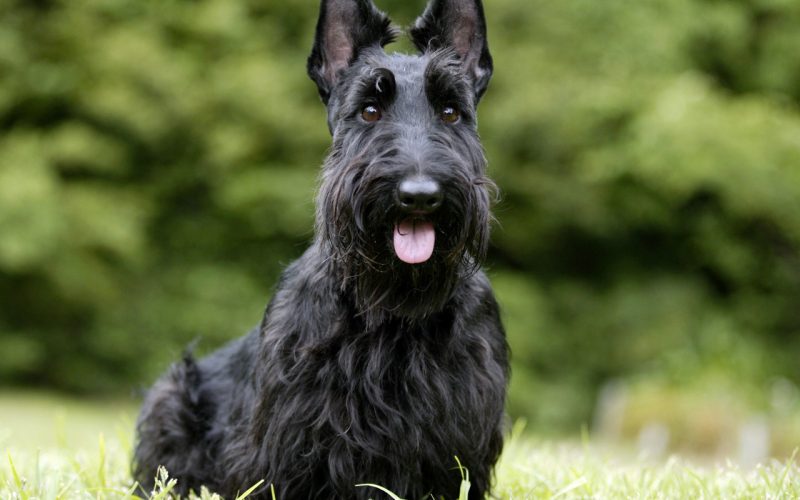
A scotch terrier is a small, cute dog that is often called a Scottish earthen dog or a Scottish terrier. Such animals are also called small gentlemen in view of the somewhat comical solidity attached to the dog with a mustache and eyebrows.
And although the sizes of scotch terriers are small, their body is still quite strong, legs, although short, but powerful.
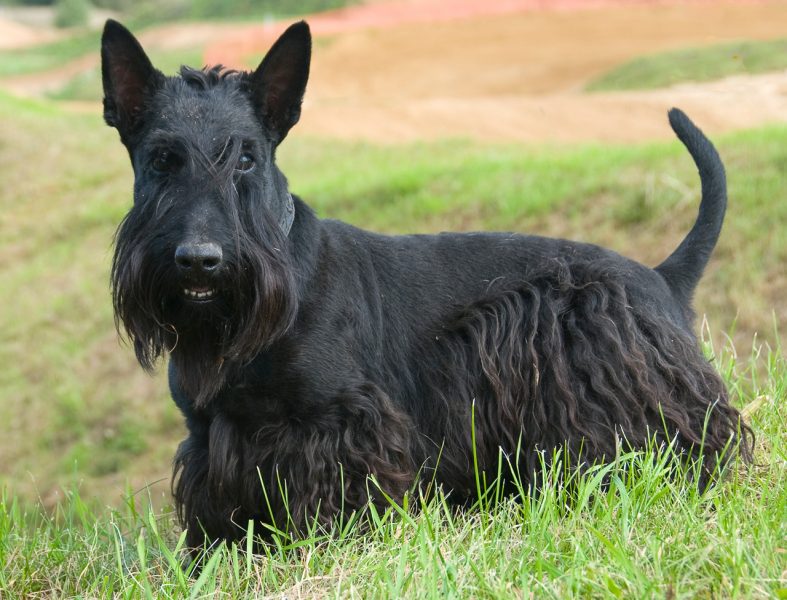
The good-natured nature of the scotch terrier borders, however, with obstinacy, often turning into overt mischief. At the same time, Scottish terriers are rather reserved towards strangers, and indeed during walks they most often demonstrate an independent look, full of dignity. But the roots of these dogs go back centuries, when their ancestors with a loud bark pulled out from deep holes of foxes and foxes. For this reason, hunting instincts are by no means alien to Scotch terriers today. While strolling around the park gradually, the pet can react violently to a cat or a rodent running by, quickly rushing forward with the intention of punishing the daring.
Based on the described features, the Scotch terrier can be called a devoted and very smart companion, whose behavior, however, needs some adjustment and full-fledged training.
Origin history
Modern cynologists cannot reliably determine how the breed of Scotch terrier was produced. There is an opinion that the efforts of the farmers and foresters of Scotland made efforts to breed the dogs. However, the latter hypothesis is at the level of assumptions, since there is no documentary evidence of this fact. Nevertheless, Scotland is called the birthplace of these funny animals. Also, some researchers are sure that the ancestors of the scotch terrier first appeared in the vicinity of the Scottish town called Aberdeen. Such animals had a funny tail, a long abdomen, they were covered with short stiff hair, which had a tiger color.
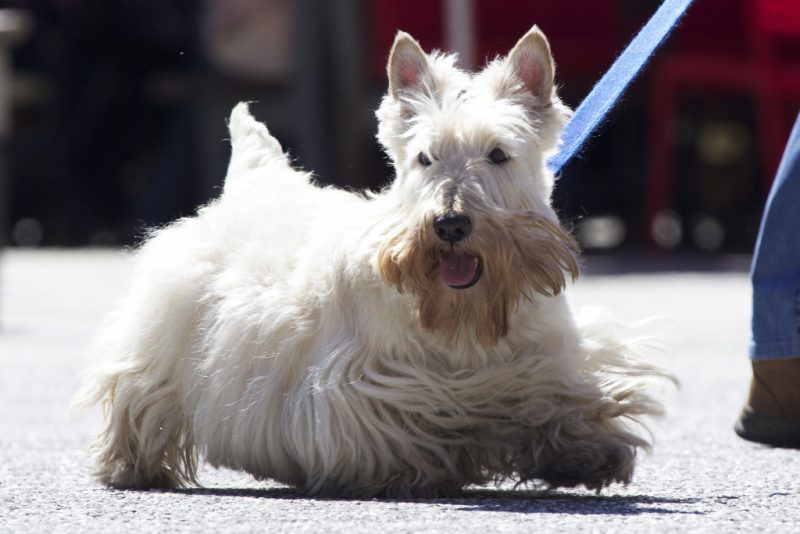
It is interesting. For many years and even centuries, Scottish terriers have called almost all dogs in the united kingdom. Over time, however, the selection did its job and the difference between the so-called burrow dogs became apparent. After several exhibitions held at the end of the 19th century, the name of the breed was assigned to the scotch terrier, and in 1879 the official breed standard was described.
They gained immense popularity in the 40s of the 20th century. Sobachek was included among his favorites by such outstanding personalities as President Roosevelt, Charlie Chaplin, Albert Einstein and others. Soviet celebrities did not lag behind them. What is Vladimir Mayakovsky alone with his pet named Skotik. Nadezhda Rumyantseva at all contained 17 dogs of this breed performing in the circus. Writers also love them. So, for scotch terriers there was a place on the pages of works by Kipling, Virginia Woolf and so on. Incredibly charming Scots decorated even Finnish stamps with their image!
Breed standard and puppy selection
When choosing, you should rely on a standard developed in 1998.
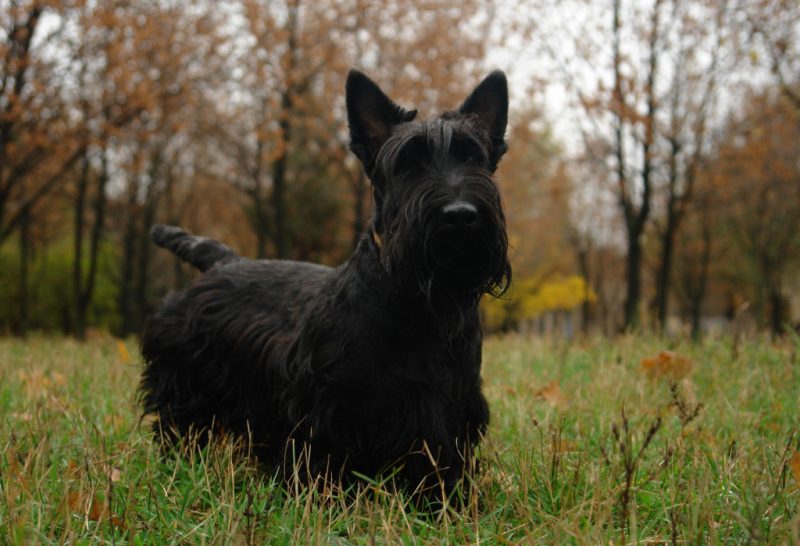
So, purebred individuals should have a head proportional to the growth of the animal. The skull of a scotch terrier is wide but flat. The nose and teeth are neat, the bite is correct. The upper teeth should be perpendicular to the lower jaw and cover it tightly. Eyes wide apart, almond-shaped, as a rule, have a dark brown tint. Rounded erect ears set not too close relative to each other. The neck is medium length, rather muscular. The back is short, massive, as is the lower back. The ribs are rounded, the tail is thick at the base, gradually tapering to the end, in the form of a straight or slightly curved. Forefeet slightly larger than hind legs.

Characteristic:
- The hair of the scotch terrier fits snugly to its body and has a soft undercoat.
- The movement of the tape terrier is smooth and free.
- The weight of an adult is 8.5-10.4 kg, the height of the body at the withers is 25.4 - 28 cm.
- The standard color of the animal is black, matte or brindle.
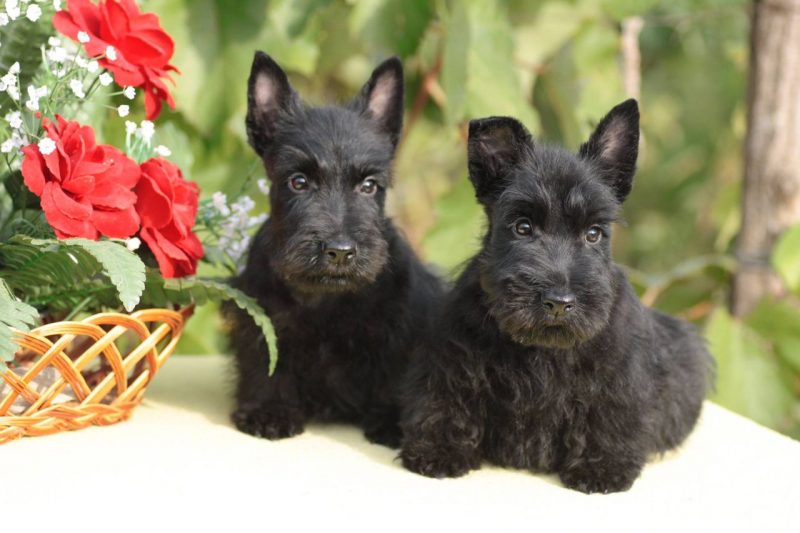
When choosing a scotch terrier puppy, a potential owner should consider some recommendations:
- Scotch terrier puppies are curious, fearless, active.
- In the selection process, it may be difficult to determine the puppy’s health status. The fact is that most of the genetic diseases may not occur until the age of six. Only three-month-old puppies can detect deafness or obvious developmental pathologies.
- Choosing a Scotsman as a home companion, it is enough to turn to pet class individuals, which allows you to purchase a thoroughbred animal for relatively little money.
- If the purchased scotch terrier subsequently should become an assistant to the owner on the hunt, the manufacturer must submit documents on passing the working tests.
- When purchasing a puppy for subsequent breeding, you should carefully check the full package of documents of the animal.
Attention! In some cases, sellers recommend that the buyer does not do the pedigree in order to save. Nevertheless, even if this information is not available, documentary evidence of the initial inspection must be. Absolutely all planned bindings should be recorded in dog handlers clubs.
Features of keeping a dog
Scotch terriers as a place of detention are equally suitable for both a private house and an apartment. However, one should not forget that these dogs have a very strong craving for digging undermines. Therefore, the risk of attacks by a miniature hunter in the area around the house is great.
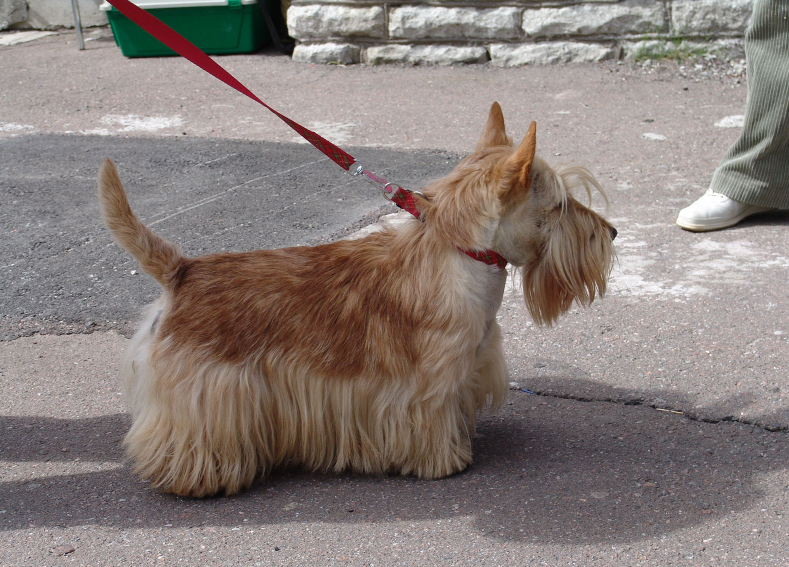
Housing must provide personal territory for scotch tape. There should be a place to sleep and a corner with bowls, toys. Since scotch terriers are very mobile and active animals, it is necessary to provide them with moderate physical activity. It is better to walk the dogs twice a day. But due to their small size, dogs are not designed for long boardwalks. You should walk the scotch terrier on a leash, because a dog who sniffs the smell of game during a procession through a forest or meadow will forget about everything in the world. Only adult animals should be released from the leash, while ensuring that the place is safe enough, and the dog will certainly return to the owner at the first call and at the same time not enter into a fight with other animals.
Care and Feeding
Caring for a Scottish terrier is not at all as complicated as it might seem. The main areas of care are claws, teeth, eyes, ears and, of course, wool.
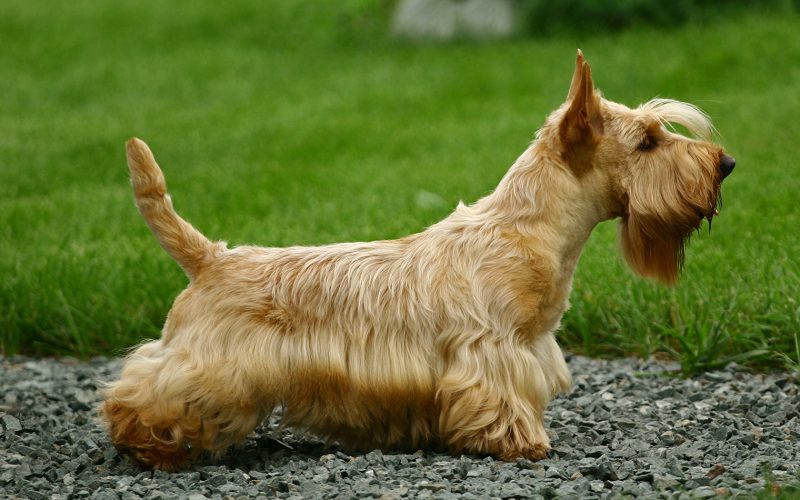
A thick long coat needs regular washing several times a month. It is recommended to choose proven high-quality shampoos and conditioners produced for bathing dogs.
After taking water procedures, you can wipe the tape with a towel. Since the dog’s hair is able to quickly grow and fall off, a timely haircut is necessary. In this case, only pets can carry out the procedure on their own. Exhibition copies can not do without professional grooming.

Terrier ears must be cleaned regularly and thoroughly. To do this, it is enough to moisten cotton buds in a special solution once a week and process the auricles, without moving, however, very deeply.
Eye care can be done using special wipes designed for dog hair in the eye area. Such funds are also suitable for the prevention of problems with the organs of vision. Tearing of the eyes of little Scots is an occasion to see a doctor.
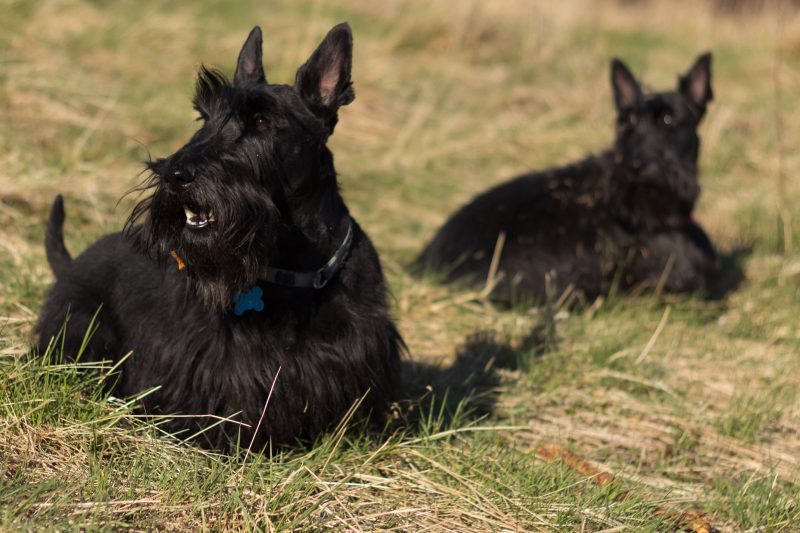
Often the teeth of adhesive tapes do not require special treatment - it is enough to maintain their whiteness and good condition with the help of special feeds and additional treats (seeds, sticks, etc.).
It is necessary to cut pet's claws - this is the main guarantee of preventing the curvature of the paws. It is especially important to track this factor in puppies. In this case, you can safely remove about 0.5 cm from the total length of the claw - this part is considered dead. The procedure should be carried out once a month using nail clippers.

For Scottish terriers, it is acceptable to eat ready-made food or natural food.
When choosing a dry food, it is worth considering several rules:
- The purchase should be carried out in specialized stores.
- Purchased feed must be of exceptional quality.
- The treat must be in a sealed package.
- Purchased feed must be protected from moisture.
- Dyes and preservatives should not be present in food.
If the choice fell on natural nutrition, it should be borne in mind that the basis of the diet should be lean beef. For puppies, it is twisted into a meat grinder, and adults are even treated with bones.
Attention! Under no circumstances should Scots be fed pork, lamb, and especially boiled bones.
Some veterinarians allow feeding Scotch terrier chicken meat and offal.Once every 7 days they are treated to boiled fish.
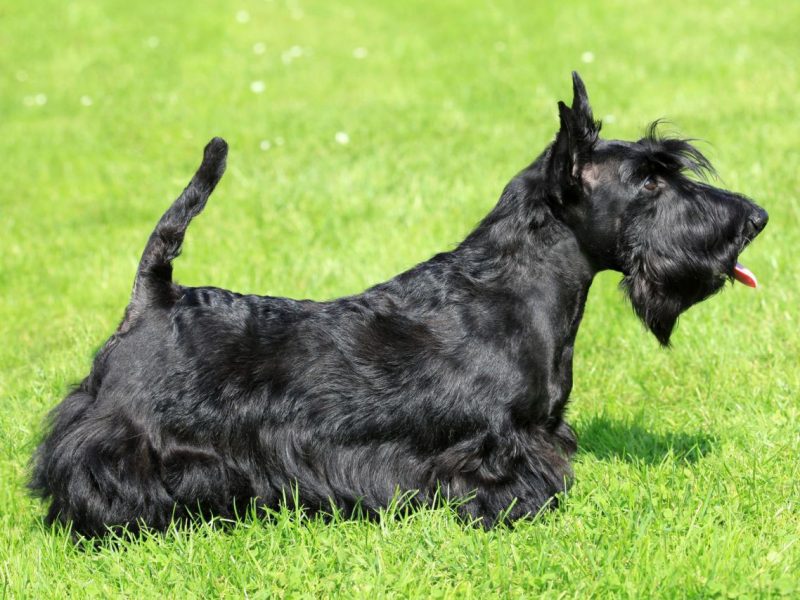
In addition to meat, scotch should be treated with vegetables and cereals (greens, apples, cucumbers, raw carrots, rice, buckwheat).
Important! Legumes, pastries, pasta, and excessively salty foods should not be added to the Scottish diet. Neglect of these rules can provoke allergies, malfunctions in the digestive tract and other problems.
How to train and educate an adhesive tape terrier
Raising a bearded pet should begin at a very young age. In case of successful training, the expected behavior norms from the animal are laid.

From the first days, pets should be accustomed to walking on a leash (the potential game that could meet on the way during a walk is to blame).
The difficulty in education lies in the variability of their mood. At the moment, they can be playful, and after a minute - willful and capricious. The most stubborn specimens require strict training, otherwise, they can grow into a truly uncontrollable creature.

Scotch terriers are sensitive to both praise and criticism. These dogs are not very fond of training, so the training process can be time-consuming and painstaking.
Tip. In the process of raising a Scottish pet, the owner should be patient and have a fair amount of time. If the latter is absent, you should attend special training courses for dogs of this breed.
Pros and cons of the breed
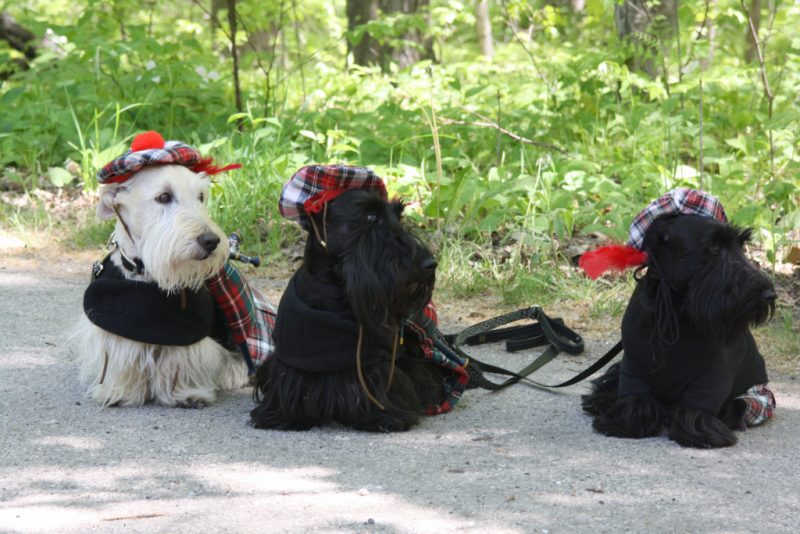
The main advantages of keeping dogs of the Scotch Terrier breed:
- The original appearance of the animal. Miniature Scots are unlikely to leave others indifferent.
- Friendly character.
- Lack of complexity in the content.
- High intelligence.
However, these animals are also characterized by some disadvantages, including:
- waywardness;
- restraint (owners who love manifestations of the pet's wild feelings should not expect this trait from the scotch terrier);
- tendency to jealousy.
How much is a scotch terrier
Representatives of adhesive tape terriers Pat-class can cost from $ 100. Breeding individuals or potential prize-winners of exhibitions and competitions are more expensive - from $ 300 and up for a puppy.
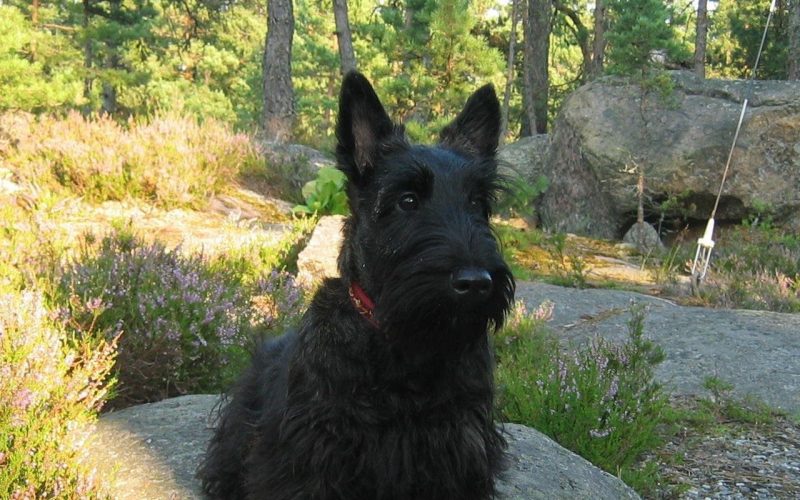
Charming scotch terriers are almost universal dogs, equally suitable for living in a private house and apartment. Raising animals, however, requires some endurance and effort from the owner. The efforts of the training pay off with interest - educated Scotch terriers are smart, faithful and disciplined.












